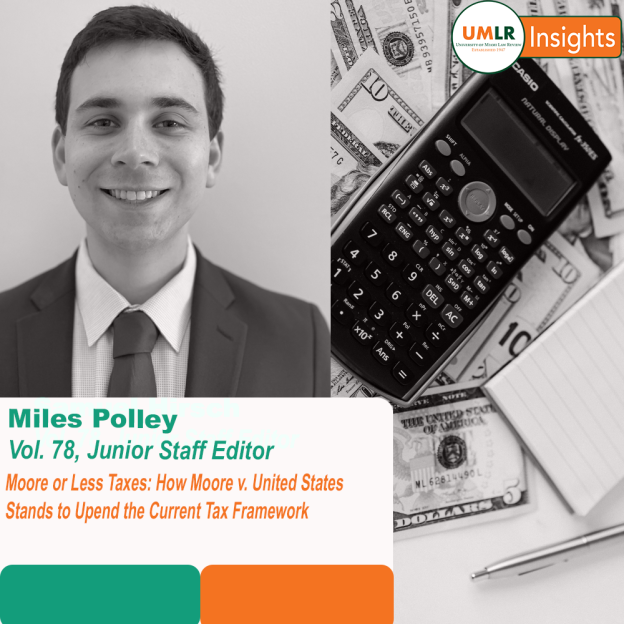MILES POLLEY—Two things are certain in life: death and taxes. Nonetheless, how much taxpayers pay in taxes remains up for debate, especially given the pending Supreme Court case Moore v. United States. The Constitution sets up two avenues of taxation: indirect and direct. To be constitutional, an indirect tax must be uniform across the country, while a direct tax needs to be apportioned among the states based on population. Historically, interpretations of the income tax towed the line between indirect and direct. However, the 16th Amendment cleared all confusion—and strengthened Congress’ power—as it allows Congress to directly tax income without apportionment.
Today, the question before the Court is whether unrealized sums fall under the definition of income and, therefore, can be directly taxed without apportionment via the 16th Amendment. The case revolves around Charles and Kathleen Moore, a couple who obtained a 13% interest in KisanKraft, an Indian company, through their $40,000 investment in 2005. KisanKraft is a controlled foreign corporation (CFC), which means U.S. shareholders own 50% or more of the company’s stock. Following the enactment of the Tax Cuts and Jobs Act of 2017 (TCJA), the Moores found themselves subject to the Mandatory Repatriation Tax (MRT), which imposes a one-time direct tax on previously untaxed foreign earnings of CFCs for U.S. shareholders owning at least 10% of the company.
Despite never receiving any distribution or dividend from their investment, the Moores were required to pay $15,000. This substantial tax liability prompted them to challenge the constitutionality of the MRT, claiming it is a direct tax on their property (i.e. their stock ownership interest in KisanKraft)—not income—without apportionment. Following losses in the United States District Court for the Western District of Washington and the 9th Circuit Court of Appeals, the Supreme Court granted the Moores’ petition for cert.
Moore v. United States evokes echoes of historical legal battles over the constitutionality of direct taxes, including the seminal Supreme Court decisions in Brushaber v. Union Pacific Railroad Co. and Eisner v. Macomber. These cases established key principles governing the taxation of income and the limits of congressional power to impose direct taxes. In oral argument, the Moores heavily relied on Macomber, claiming it stands for the proposition that a taxpayer does not receive income by way of increases in investment value. Yet, overlooked and under-argued was also the fact that the Supreme Court, in Macomber, stated that Congress cannot statutorily choose what falls under the definition of income, as that would allow Congress to amend the Constitution without formal proceedings.
In light of this, the Internal Revenue Code (IRC) does not define “income”; the government even admitted this during oral argument. Only “gross income” is defined in the IRC, albeit circularly as it includes the word “income” in its definition. Thus, the Supreme Court, in answering the question presented, is also confronted with the challenge of updating the definition of “income.” This added responsibility, given the sweeping impact of defining “income,” incentivizes the Court to address Moore v. United States from a different point of view.
Three possible outcomes exist: first, the Supreme Court affirms the lower court decision; second, the Supreme Court determines the MRT is unconstitutional; or third, the Supreme Court upholds the MRT on a narrow basis. The first two scenarios require the Supreme Court to modify the interpretation of “income.” Justices Alito, Gorsuch, and Thomas seemed hesitant to adopt the government’s argument that striking down the MRT would result in billions of lost tax revenue, instead choosing to question the possibilities of taxing unrealized gains in real estate and retirement accounts. On the other hand, Justices Jackson, Kagan, and Sotomayor brushed off concerns that Congress may impose wealth taxes if the MRT is allowed to stand, rationalizing that members of Congress hope to be reelected. The remaining Justices remained receptive to both sides, hinting that the third scenario may be the most likely outcome. After all, a finding that the MRT targets and collects a CFC’s realized income through its shareholders dodges the ultimate question of constitutionality, does not require a new definition of “income,” and neither extends nor limits Congress’ taxing power.
All the dust will soon be settled, but as the Supreme Court deliberates on the merits of the Moores’ challenge, it is important to weigh, consider, and plan for all the potential implications that certainly extend far beyond the confines of the courtroom. The Court’s ruling has the potential to shape the contours of tax policy, influence corporate behavior, and resonate with the principles enshrined in the Constitution.






